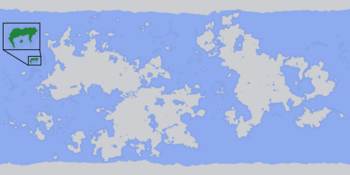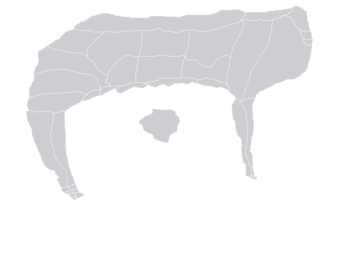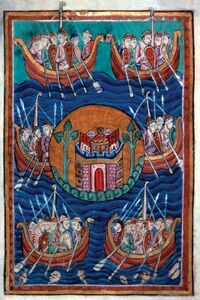Hatstheput
Foral Kingdom of Hatstheput Reino Foral de Hatsdeput | |
|---|---|
| Motto: "Liberty, Meritocracy and Justice" | |
| Anthem: Anthem of Liberty | |
 | |
 | |
| Capital and | Hatstheput City |
| Official languages | Spanish |
| Ethnic groups |
|
| Religion | Aconfessional State
|
| Demonym(s) | Hatstheputian |
| Government | Joint-stock semi-constitutional monarchy |
• King | Santiago II |
| Francisco Torrijos (MP) | |
| Pablo Requejo (MP) | |
| Juan Carlos Dresde (MP) | |
| Antonio Castillo | |
| Formation | |
• Independence | 1114 |
• Prybournean Integration | 1787 |
• Liberal State | 1890 |
| Area | |
• | 93,451 km2 (36,082 sq mi) |
| Population | |
• 2017 estimate | 29,000,000 |
• Density | 310/km2 (802.9/sq mi) |
| GDP (PPP) | estimate |
• Total | 441.000.000.000$ (94º) |
• Per capita | 40,157$ (36º) |
| Gini | high (3º) |
| HDI (29/05/2017) | very high |
| Currency | Quasa (QUAS) |
| Time zone | UTC-12 |
| Date format | dd.mm.yyyy |
| Driving side | right |
| Calling code | +741 |
| ISO 3166 code | HAT |
| Internet TLD | .ht |
The Foral Kingdom of Hatstheput (Spanish: Reino Foral de Hatsdeput) is a small country which lies on the island of Hatstheput located in the Western continent of Anteria. Such a nation is constitutionally defined as a "foral monarchy", dividing itself into 35 administrative provinces and, uniquely, operating under an explicitly "for profit" basis materialized in a government structure resembling that of a joint-stock company. Hatstheput is also a member state of the Dokodo Union.
Hatstheput's geography is characterized by a temperate, continental climate that has very limited thermic amplitude, moderate temperature and significant precipitations throughout all the year. Mountainous climate, in which precipitations descend in the form of snow and lower temperatures are observed, can also be found on the northeastern part of Hatstheput, where the Torreones Range is found. In terms of orography, Hatstheput is primarily a flat nation but for the previously mentioned peaks which lie in its northwestern region. Hatstheput's detachment from the rest of the Western continent grants it a wide spectrum of endemic fauna and flora, amongst which it's worth mentioning the Ivory Eagle.
Prior to the arrival of Neuew Zeevolk navigants around the year 900, it's believed there was little to no human presence within Hatstheput. These navigants would configure the Merchant Kingdom of Hatstheput in the year 1114, independent from the rest of Zeevolk domains. Making use of their privileged location to control trade between the Zeevolk realms to the northeast and the Romance neighbors to the south, Hatstheput would eventually become a renownedly wealthy nation that will attract merchants from the Canter Empire. The influence of these merchants would strenghten as will their number in Hatstheput, ultimately causing Hatstheput to integrate within the Canter Empire as a protectorate as a means to acquire commercial benefits in 1467. This integration would eventually cause a cultural change within Hatstheput as well, with Spanish-speaking merchants from the Bournean region of the Canter Empire gradually converting Spanish into the de facto trade language of Hatstheput. The Hatstheputian administration will accept Spanish as the official language of Hatstheput in 1631. With the proclamation of the Canter Republic in 1787, king Fernando II will convoke a referendum to integrate Hatstheput as an autonomous federal republic within the new régime pressured by his enlightened, bourgeois advisors, a plebiscite that will have a positive outcome. With the breakout of the Canter Revolution in 1884, Hatstheput will stay loyal to the Canter Republic to the very end of the conflict, despite the corporatist Hatstheputian Victory Front will form within its borders in defense of the insurgents. In 1890, Hatstheput will obtain its independence after the collapse of the republican régime. Consequently, a federal republic will be formed, with the souverainist Moderate Party and the Pan-Canterian Conservative Party dominating the political scene of Hatstheput until the 1930s. Such decade will be marked by increasing polarization at the hands of trade unions, the newly founded Radical Party, and the terrorist organization Red Dawn in response of what was perceived as an unwarranted adherence to laissez-faire policies. The tumultuous period will culminate in the self-abolishment of representative government by the People's Monarchist Front in 1941, which will be replaced by a semi-constitutional monarchy where the monarch will espouse absolute power de facto despite his honored committment to respect individual liberties embodied in the Hatstheputian Carta Magna. Under the influence of the most uncompromising thinkers of the Hatstheputian School of Economics, Hatstheput will go on to become the first "for-profit" government in Anteria by emitting stock and will intensify its libertarian policy-making by incorporating the volenti non fit injuria principle into the constitution and eliminating import tariffs. In 1996, Hatstheput will join the Dokodo Union as part of Santiago II's attempts to incorporate the island state into the global economy.
Etymology
It's believed that the name "Hatstheput" comes from the old Hatstheputian runic language, referring to a "promised land". Therefore, the Spanish noun "Hatsdeput" was derived from a hispanization of the original pronunciation, appearing first in a Canter encyclopedia around the 13th centry.
Another discarded hypothesis suggested that the name could have been placed by King Joffric to honor an unknown deceased son of his, but there are no written records supporting such a claim other than a dubious book describing multiple legends that circulated in the early 19th century.
History
Precolonization Period
Prior to the arrival of the Zeeite Neuew colonizers, there will be little to no human presence in Hatstheput. Although certain locations with seemingly humanoid interaction have been found, these are attributed to other beings comprised within the wide homo suborder rather than to modern humans per se. It's also worth noting that the island of Hatstheput had been previously mentioned in Zeeite engravings in a generic way. Specifically, an anonymous Neuew record of a travel westward across the ocean mentioned a stop taking place in a seemingly undiscovered island that's generally considered by historians to correspond with Hatstheput. Although it's highly likely that former temporary Zeeite settlements may have been established in the island of Hatstheput given its intermediate location between the two continents of Anteria, no physical proof of their existence has been found to this day.
Middle Ages
Human history within Hatstheput will commence with the expedition of Neuew duke Joffric to it. Despite the royal support to such endeavor and the fact that Joffric would claim the island for Neuewland, Hatstheput will be granted a high degree of autonomy in light of the distance between the two territories. This factor, alongside the feudal model which impered at the time, will virtually turn Joffric into the absolute ruler of the entirety of the island, a pattern that will continue for decades as his heirs will take the throne. During his rule, Joffric will divide the entirety of the Hatstheputian territory amongst his main commanders and focus on establishing trade relations with the neighboring territories, something that would foster island development. A particularly credited move on his behalf would be visiting the southern romance realms to apprehend their most superior technical methods.
The successive heirs of Joffric will benefit from his ancestor's intelligent administration, that will keep them as popular figureheads arguably more influential within the island that the Neuew monarchy. Simultaneously, the increasing commercial contacts with the southern neighbors of Hatstheput will translate into the arrival of the first Catholic missions to Hatstheput. Despite these missions will be prohibited and actively persecuted until 1050, in posterior years they will be accepted and Catholicism will be progressively expanded across Hatstheput in substitution of the traditionally Neuew Oceanist faith. In 1113, insular count Hjalid will personally embrace Catholicism and institute it as the official confession of the entirety of Hatstheput, a move that will culminate a progressive separation between mainland Neuewland and Hatstheput as Hatstheputians will no longer regard a heretic king as a valid ruler. Consequently, Hjaelid Joffricsson will be crowned as Hjaelid I, marking the beginning of the independent Merchant Kingdom of Hatstheput.
This new nation will make use of its sovereignty to strengthen relations with the southern nations, specifically with the growing Canter Kingdom. This will lead to an increasingly profitable influx of commerce that will convert Hatstheput in a trade hub that will regulate all naval transport between its Romance neighbors and the Zeevolk nations. The cultural influence of the adoption of Catholicism and the constant contact with Canter merchants will translate into the Latinization of the Zeeite alphabet employed in Hatstheput as well as in the integration of certain Spanish grammatic rules and loanwords into its vocabulary, hence giving birth to the Hatstheputian language approximately in 1300.
Modern Age
Contemporary Age
Economy
Hatstheput exhibits a developed, tertiary free-market capitalist economy that distinguishes itself from the rest of Anteria due to its small public sector, lax regulatory framework, and low taxes. These defining features are often believed to contribute to the island's exceptional appeal to investors and entrepreneurs, which alongside the island's privileged location for trade operations, make Hatstheput feature one of the highest standards of living in Anteria. The economy of Hatstheput also manifests a healthy situation in other relevant macroeconomic indicators, with minimal perennial unemployment persistently oscillating between 2 and 4% and a mere 20% of debt as a percentage of GDP. As part of the Third Millennium Agenda, the government has also been enforcing a principle of budget neutrality since 2000 by which the government is committed to not run public deficits except in instances of war, recession, or catastrophic events.
The most dominant sectors in Hatstheput are banking, tourism, computing, and biotechnology. Due to the high wages across the country, the Hatstheputian economy is predominantly centered around high-value industries relying on qualified human capital, technological innovations, and a business-friendly legal environment. Hatstheput also owes the existence of a thriving transport industry to its geographical positioning between Prybourne and the Zeevolk countries, posessing one of the largest seaports and airports in the region. In recent decades, tourism has become an increasingly profitable source of income for the island thanks to Hatstheput's beaches, landsites, and ample leisure offer.
There is a very notable wealth gap between the Protestant North, more agrarian and rural, and the Catholic South, more industrialized and urban.
Education and science
Hatstheput's educative system is remarkable in Anteria for being austere and flexible. Strongly committed to the principle of subsidiarity, Hatstheput's government neither operates nor funds any educational center within its territory. As such, schools and universities are operated by private agents with ample freedom to define their own curriculums, guidelines, and selection criteria. Scholarization rates remain similar to those of other countries with public systems since elementary education is considered a legal obligation of parenthood and, from a cultural standpoint, Hatstheputian families are inclined to deeply value education.
Despite the majority of centers are laic, a significant portion of schools and universities are either dependent or adjacent to the Catholic Church, whose influence over education is comparatively larger to that of other countries. Due to the absence of central regulations, Hatstheputian schools are often among the educational vanguard when it comes to innovations in the field of pedagogy. Project-oriented grading, teacher feedback, debate programs, and vocational specialization are some of the features that Hatstheputian schools generally exhibit in contrast to most educational systems throughout the world. Unique subjects such as domestic finances, debate, or programming are also present at many Hatstheputian curriculums usually offering favorable results. Gifted and 2e programs are also widespread despite being disencouraged in other systems where greater emphasis on homogeneity of standards and curriculum is placed.
In terms of science, Hatstheputians have achieved several successes. Hatstheputian scientists invented the RN72 Rifle, the submarine, the helicopter and the electric car.
Infrastructure, energy and environment
Energy by mean of production
Hatstheputian infrastructures are unique in Anteria due to the degree of privatization to which they are subject. Highways, motordrives, and roads spanning across multiple municipalities all remain in private hands, with intramunicipal roads remaining public for the sake of urban planning. Despite most of these connections are paid thanks to advertisement revenue due to the competitive constraints their operators often face, tolls and satellite pricing systems are also in place throughout multiple roads. The island's railway network, airports, and ports are similarly private, with them being owned and operated by numerous private companies within the context of a free market. Economists and other experts have often questioned whether or not privatization is the most efficient course of action by which to manage transport infrastructure, although Hatstheput remains a frequent example cited by free-market thinkers as a success.
Electricity production in Hatstheput is also in private hands. Most of Hatstheput's energy is produced by nuclear power stations, which account for 82% of the total electricity produced in Hatstheput. Hatstheput's lax regulatory framework in the ambit of nuclear energy is often credited as explaining the island's low market prices for electricity and its complete self-sufficiency.
Demography
Religion
The most popular religion in Hatstheput is Catholicism, followed by Protestantism and Capitology. There are also notable religious minorities among the country's urban centers, including Eastern Orthodoxy, Sunni Islam, and Zeeite faith. A growing portion of the population identifies as either atheist or agnostic, a category now spanning 20% of self-identified Hatstheputians as of a 2021 poll.
Language
Spanish is the primary language of Hatstheput, being spoken by the virtual entirety of Hatstheputians and declared official by the Hatstheputian Magna Carta. Hatstheputian, a lingua franca that was gradually replaced by Spanish as Prybournean influence over the island intensified, is still used in certain rural regions of inland Hatstheput as a secondary language.
As Hatstheput evolved into a global hub for trade and financial activity in recent decades, it has become more common to find foreign languages being used within its most prominent commercial centers. English in particular has become highly appreciated because of its frequent use in the international business sphere, with Hatstheputian schools placing heavy emphasis on its learning and its knowledge being a requirement for most jobs in the island.
Cities
| City | Population (local) | Population (metropolitan) |
|---|---|---|
| Hatstheput City | 3,314,286 | 4,974,271 |
| Victoria | 2,320,000 | 3,000,000 |
| Monteleón | 800,000 | 3,000,000 |
| Villa del Rey | 625,000 | 700,000 |
Inmigration
Immigration is uncommon in Hatstheput as its legislation concerning immigration is substantially more conservative than that of other countries and it is an island. Only 5% of the population is of foreign origin. Despite being a colonial nation, the Hatstheputian government has consistently valued cultural homogeneity as a worthwile goal since the restoration of the monarchy and has consequently instituted highly selective immigration standards. Notably, only qualified professionals, wealthy individuals, and Canterian citizens were allowed to reside for prolongued periods of time in Hatstheput until the adherence of the insular government to the Dokodo Union, a decision that marked the incorporation of Hatstheput into an open borders international zone. Despite such choice was assumed to trigger a large migratory influx by some when first adopted, the situation barely changed given that Hatstheput continued being a relatively remote country lacking land borders.
The most sizable foreign communities in Hatstheput come from Prybourne, Neuewland, Aziallis, and Gabrielland. The first two are well-established and were prominent since Hatstheput's independence while the latter two mainly propagated after the admission of Hatstheput into the Dokodo Union. Other countries of the Canterian cultural sphere, such as Gavrilia or Riamo, have also consolidated a diaspora throughout Hatstheput in recent years.
Culture
The Hatstheputian culture is heavily influenced by that of Prybourne despite it exhibiting numerous unique features of its own.
Literature
The oldest written work found in Hatstheput was found in the Ruhan Temple, in the Singa city of Bandar Emas. It was the Drumidari, a large mythologic epic describing how the world was created by the Singa gods, and how this were born. Few other written works from the Singa era were found on Hatstheput, and it is known that a large part of books describing the Singa mythology were burnt down in the Red Night, in which king Gamal I ordered the deletion of all books and artwork which could be considered "heretic" by the standards of the high Muslim clergy of the time.
After the Singa era, most books were written in both Hofflandian and English, the languages of the colonizers of Hatstheput. The most relevant classic writers of Hatstheput were Hermann Draxler, who wrote several novels such as "East Hatstheput" or "The Men of the Bay", with a heavy social critic towards "the lazy and evil, the scum of our society", in which he subtly promoted his liberal-conservative views, and John Henry Norris, who wrote novels such as "The Price of Freedom" or "Ronald" in which he critiziced the bussiness practics of the time and the "worrying" situation of the working class.
Festivities
| Date | Name | Working day |
|---|---|---|
| January 1st | New Year's Day | No |
| January 6th | Three Kings Day | No |
| February 14th | Valentine's Day | Yes |
| Spring | Holy Week | No |
| April 1st | April Fool's Day | Yes |
| May 22nd | Revolution Day | No |





